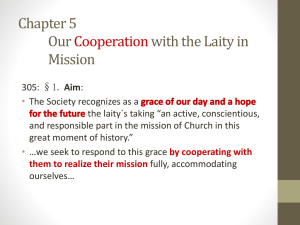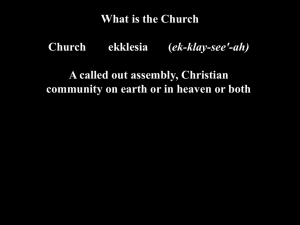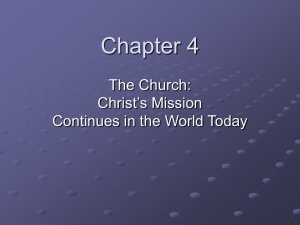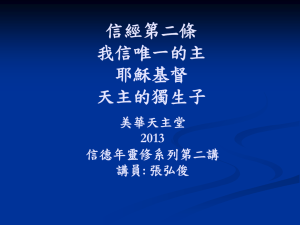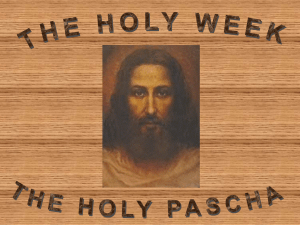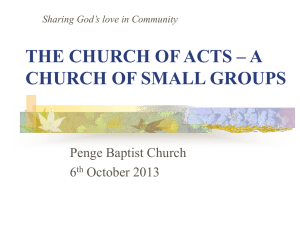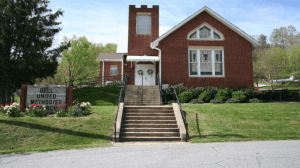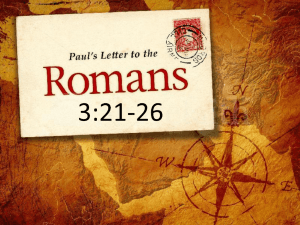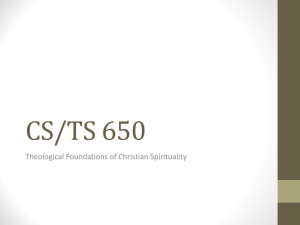The Church, the Light of Nations - St. Mary of the Miraculous Medal
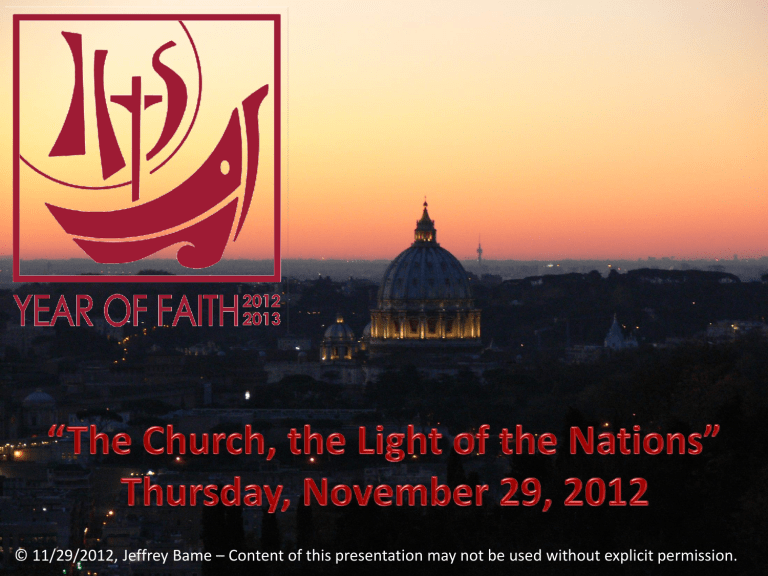
© 11/29/2012, Jeffrey Bame – Content of this presentation may not be used without explicit permission.
“The Church, the Light of the Nations”
Cornerstone document: Dogmatic Constitution on the Church: Lumen Gentium
Date: November 21, 1964
English Copy: http://www.vatican.va/archive/hist_councils/ii_vati can_council/documents/vatii_const_19641121_lumen-gentium_en.html
Spanish Copy: http://www.vatican.va/archive/hist_councils/ii_vati can_council/documents/vatii_const_19641121_lumen-gentium_sp.html
Outline of
Lumen Gentium (LG)
Ch. 1 - The Mystery of the Church
Ch. 2 - On the People of God
Ch. 3 - The Hierarchical Structure of the Church
Ch. 4 - The Laity
Ch. 5 - The Universal Call to Holiness
Ch. 6 - Religious
Ch. 7 - Eschatological Nature of the Pilgrim Church
Ch. 8 - The Blessed Virgin Mary, Mother of God
Tonight’s Outline
1. The Mystery of the Church
2. The Mystical Body of Christ
3. Church Hierarchy
4. The Laity
5. Salvation – Is the Church Necessary?
6. Family – the Domestic Church
7. Call to Holiness
8. The Mission of the Pilgrim Church
Tonight’s Outline
1. The Mystery of the Church
2. The Mystical Body of Christ
3. Salvation – Is the Church Necessary?
4. Church Hierarchy
5. The Laity
6. Family – the Domestic Church
7. Call to Holiness
8. The Mission of the Pilgrim Church
1. The Mystery of the Church
God created the world and man according to his mysterious plan, in His wisdom and goodness.
His plan was to raise man to participation in divine life
After the fall of man (original sin), he foreshadowed the Church through his covenants and promises
Through Christ and the outpouring of the Holy Spirit at
Pentecost, the Church was made manifest
“At the end of time, it will gloriously achieve completion, when…all the just…will be gathered together with the Father in the universal Church.”
( LG 2)
Ch. 1 – The Mystery of the Church
The Church is (the four marks of the Church):
One – unity found in her source: the Holy Trinity
Holy – filled with the Holy Spirit and made one in marriage with Christ
Catholic – universal through the presence of Christ in her as well as in her mission to the whole human race
Apostolic – founded on the apostles
LG 8 and CCC (Catechism of the Catholic Church
813, 823, 830-831, 857)
Ch. 1 – The Mystery of the Church
Christ is the Head of the Church, which is the Mystical
Body of Christ (of which we are all members)
Metaphors for the Church
Sheepfold (Is 40:11; Ez 34:11; Jn 10:1-10)
Land to be cultivated (Mt 21:33-43; Jn 15:1-5; 1
Cor 3:9)
The building of God (Mt 21:42; 1 Cor 3:9)
Our Mother (Gal 4:26; Rv 12:17; Rv 19:7
The Church is also seen as the virginal Bride of Christ
(see parables of the bridegroom)
1. The Mystery of the Church
A Pilgrim Church…
“The Church, ‘like a stranger in a foreign land, presses forward amid the persecutions of the world and the consolations of God’, announcing the cross and death of the Lord until He comes. By the power of the risen
Lord it is given strength that it might, in patience and in love, overcome its sorrows and its challenges, both within itself and from without, and that it might reveal to the world, faithfully though darkly, the mystery of its
Lord until, in the end, it will be manifested in full light.”
(LG 8)
Tonight’s Outline
1. The Mystery of the Church
2. The Mystical Body of Christ
3. Salvation – Is the Church Necessary?
4. Church Hierarchy
5. The Laity
6. Family – the Domestic Church
7. Call to Holiness
8. The Mission of the Pilgrim Church
2. The Mystical Body of Christ
“For as in one body we have many members, and all the members do not have the same function, so we, though many, are one body in Christ, and individually members one of another.” (Rom 12:4-5)
“For just as the body is one and has many members, and all the members of the body, though many, are one body, so it is with Christ. For by one Spirit we were all baptized into one body – Jews or Greeks, slaves or free – and all were made to drink of one
Spirit.” (1 Cor 12:12-13)
2. The Mystical Body of Christ
Mystici Corporis Christi – Pope Pius XII, 1943
Pius XII takes scripture and tradition and coins this term – “Mystical Body of Christ”
Lumen Gentium affirms this theory, teaching that the
Church is more than a human institution or a political structure, but is a mystical, spiritual reality – the
MBOC is made up of all of the baptized faithful who are joined in spirit with Christ the Head. This union is experienced and continually maintained through the
Eucharist.
2. The Mystical Body of Christ
We speak of the Mystical Body of Christ and in comparison, we see the very visible structures of the
Church.
“But, the society structured with hierarchical organs and the Mystical Body of Christ, are not to be considered as two realities, nor are the visible assembly and the spiritual community, nor the earthly
Church and the Church enriched with heavenly things; rather they form one complex reality which coalesces from a divine and a human element.” (LG 8)
2. The Mystical Body of Christ
We are not individuals who go to church – we are
Church.
Not about “just me and Jesus”
We see this in the Eucharistic sacrifice of the altar in which we are unified with all believers in Christ.
“All men are called to this union with Christ, who is the light of the world, from whom we go forth, through whom we live, and toward whom our whole life strains.” (LG 3)
Tonight’s Outline
1. The Mystery of the Church
2. The Mystical Body of Christ
3. Salvation – Is the Church Necessary?
4. Church Hierarchy
5. The Laity
6. Family – the Domestic Church
7. Call to Holiness
8. The Mission of the Pilgrim Church
3. Salvation – Is the Church Necessary?
“Basing itself upon Sacred Scripture and Tradition, it teaches that the Church, now sojourning on earth as an exile, is necessary for salvation. Christ, present to us in
His Body, which is the Church, is the one Mediator and the unique way of salvation. In explicit terms He Himself affirmed the necessity of faith and baptism and thereby affirmed also the necessity of the Church, for through baptism as through a door men enter the Church.
Whosoever, therefore, knowing that the Catholic Church was made necessary by Christ, would refuse to enter or to remain in it, could not be saved.” (LG 14)
3. Salvation – Is the Church Necessary?
“Catechumens who, moved by the Holy Spirit, seek with explicit intention to be incorporated into the
Church are by that very intention joined with her. With love and solicitude Mother Church already embraces them as her own.” (LG 14)
“He is not saved, however, who, though part of the body of the Church, does not persevere in charity.” The faithful must remember that our status as God’s children is a gift of grace. “If they fail moreover to respond to that grace in thought, word and deed, not only shall they not be saved but they will be the more severely judged.” (LG 14)
3. Salvation – Is the Church Necessary?
Salvation of Other Christians, Non-Christians?
Salvation of Agnostics and atheists?
“Those can also attain to salvation who through no fault of their own do not know the Gospel of Christ or His
Church, yet sincerely seek God and moved by grace strive by their deeds to do His will as it is known to them by the dictates of conscience…Nor will divine providence deny the assistance necessary for salvation to those who, without any fault of theirs, have not yet arrived at an explicit knowledge of God, and who, no without grace, strive to lead a good life.” (LG 16)
Tonight’s Outline
1. The Mystery of the Church
2. The Mystical Body of Christ
3. Salvation – Is the Church Necessary?
4. Church Hierarchy
5. The Laity
6. Family – the Domestic Church
7. Call to Holiness
8. The Mission of the Pilgrim Church
4. Church Hierarchy
Apostolic succession – the bishops come from the line of the apostles (LG 20)
“The individual bishops represent each his own church, but all of them together and with the Pope represent the entire Church in the bond of peace, love and unity.” (LG 23)
A bishop’s primary role is to preach the Gospel
“In matters of faith and morals, the bishops speak in the name of Christ and the faithful are to accept their teaching and adhere to it with a religious assent.” (LG
25)
4. Church Hierarchy
In the early church, the bishops ordain priests
(presbyters) to share in their priestly ministry in order that the Eucharist and the sacraments may be celebrated more often in more places
“Priests are united with bishops and by the power of
Orders, in the image of Christ the high priest, they preach the Gospel, shepherd the faithful, and celebrate divine worship.” (LG 28)
Ordained priesthood vs. common priesthood – the ministerial priesthood is at the service of the common priesthood of believers
4. Church Hierarchy
“It is not right that we should give up preaching the word of God to serve tables. Therefore, brethren, pick out from among you seven men of good repute, full of the Spirit and of wisdom, who we may appoint to this duty. But we will devote ourselves to prayer and to the ministry of the word.” (Acts 6:2-4)
Over the centuries, the diaconate faded away as a permanent state – restored by Vatican II (LG 29)
Deacons have hands imposed, but “not unto the priesthood, but unto a ministry of service.” (LG 29)
4. Church Hierarchy
Pope as Bishop of Rome
Matthew 16:18-19 as scriptural foundation of papacy
“And in order that the episcopate itself might be one and undivided, He placed Blessed Peter over the other apostles, and instituted in him a permanent and visible source and foundation of unity of faith and communion.” (LG 18)
4. Church Hierarchy
Papal infallibility – myth vs. reality
"After the reading of the foregoing epistle [The Tome of Leo], the most reverend bishops cried out: ‘This is the faith of the fathers! This is the faith of the apostles! So we all believe! Thus the orthodox believe!
Anathema to him who does not thus believe! Peter has spoken thus through Leo! . . . This is the true faith!
Those of us who are orthodox thus believe! This is the faith of the Fathers!’" (Council of Chalcedon, session
2, A.D. 451)
Tonight’s Outline
1. The Mystery of the Church
2. The Mystical Body of Christ
3. Salvation – Is the Church Necessary?
4. Church Hierarchy
5. The Laity
6. Family – the Domestic Church
7. Call to Holiness
8. The Mission of the Pilgrim Church
5. The Laity
The Laity defined:
“The term laity is here understood to mean all the faithful except those in holy orders and those in the state of religious life specially approved by the Church. These faithful are by baptism made one body with Christ and are constituted among the People of God; they are in their own way made sharers in the priestly, prophetical, and kingly functions of Christ; and they carry out for their own part the mission of the whole Christian people in the Church and in the world.” (LG 31)
5. The Laity
“But the laity, by their very vocation, seek the kingdom of
God by engaging in temporal affairs and by ordering them according to the plan of God. They live in the world, that is, in each and in all of the secular professions and occupations. They live in the ordinary circumstances of family and social life, from which the very web of their existence is woven. They are called there by God that by exercising their proper function and led by the spirit of the Gospel they may work for the sanctification of the world from within as a leaven. In this way they may make Christ known to others, especially by the testimony of a life resplendent in faith, hope and charity.” (LG 31)
5. The Laity
“For their pastors know how much the laity contribute to the welfare of the entire Church. They also know that they were not ordained by Christ to take upon themselves alone the entire salvific mission of the
Church toward the world. On the contrary they understand that it is their noble duty to shepherd the faithful and to recognize their miniseries and charisms, so that all according to their proper roles may cooperate in this common undertaking with one mind.” (LG 30)
Charisms, gifts of the Holy Spirit
5. The Laity
“For all their works, prayers and apostolic endeavors, their ordinary married and family life, their daily occupations, their physical and mental relaxation, if carried out in the Spirit, and even the hardships of life, if patiently borne—all these become ‘spiritual sacrifices acceptable to God through Jesus Christ’. Together with the offering of the Lord's body, they are most fittingly offered in the celebration of the Eucharist. Thus, as those everywhere who adore in holy activity, the laity consecrate the world itself to God.” (LG 34)
Tonight’s Outline
1. The Mystery of the Church
2. The Mystical Body of Christ
3. Salvation – Is the Church Necessary?
4. Church Hierarchy
5. The Laity
6. Family – the Domestic Church
7. Call to Holiness
8. The Mission of the Pilgrim Church
6. Family – The Domestic Church
“The family is, so to speak, the domestic church. In it parents should, by their word and example, be the first preachers of the faith to their children; they should encourage them in the vocation which is proper to each of them, fostering with special care vocation to a sacred state.” (LG 11)
6. Family – The Domestic Church
“For where Christianity pervades the entire mode of family life, and gradually transforms it, one will find there both the practice and an excellent school of the lay apostolate. In such a home husbands and wives find their proper vocation in being witnesses of the faith and love of Christ to one another and to their children. The
Christian family loudly proclaims both the present virtues of the Kingdom of God and the hope of a blessed life to come. Thus by its example and its witness it accuses the world of sin and enlightens those who seek the truth.” (LG 35)
6. Family – The Domestic Church
“Thus the home is the first school of Christian life and ‘a school for human enrichment.’ Here one learns endurance and the joy of work, fraternal love, generous
– even repeated – forgiveness, and above all divine worship in prayer and the offering of one’s life.” (CCC
1657)
“…those in society who are in charge of schools must never forget that the parents have been appointed by
God Himself as the first and principal educators of their children and that their right is completely inalienable.”
( Familiaris Consortio 40)
6. Family – The Domestic Church
Holy Family as model – they underwent trials of poverty, persecution, and exile, yet glorified God.
“Thus the little domestic Church, like the greater
Church, needs to be constantly and intensely evangelized: hence its duty regarding permanent education in the faith.” ( Familiaris Consortio 52)
“The future of humanity passes by the way of the family.” ( Familiaris Consortio 86)
Tonight’s Outline
1. The Mystery of the Church
2. The Mystical Body of Christ
3. Church Hierarchy
4. The Laity
5. Salvation – Is the Church Necessary?
6. Family – the Domestic Church
7. Call to Holiness
8. The Mission of the Pilgrim Church
7. Call to Holiness
“Fortified by so many and such powerful means of salvation, all the faithful, whatever their condition or state, are called by the Lord, each in his own way, to that perfect holiness whereby the Father Himself is perfect.” (LG 11)
“Therefore in the Church, everyone whether belonging to the hierarchy, or being cared for by it, is called to holiness, according to the saying of the Apostle: ‘For this is the will of God, your sanctification’.” (LG 39; cf
1 Thess 4:3; Eph 1:4)
7. Call to Holiness
For priests:
“They participate in the grace of their office and they should grow daily in their love of God and their neighbor by the exercise of their office through Christ, the eternal and unique Mediator. They should preserve the bond of priestly communion, and they should abound in every spiritual good and thus present to all men a living witness to God.” (LG 41)
7. Call to Holiness
For married persons:
“Furthermore, married couples and Christian parents should follow their own proper path (to holiness) by faithful love. They should sustain one another in grace throughout the entire length of their lives. They should embue their offspring, lovingly welcomed as God's gift, with Christian doctrine and the evangelical virtues.” (LG
41)
7. Call to Holiness
For single and widowed persons:
“A like example, but one given in a different way, is that offered by widows and single people, who are able to make great contributions toward holiness and apostolic endeavor in the Church.” (LG 41)
7. Call to Holiness
For ALL people:
“Finally all Christ's faithful, whatever be the conditions, duties and circumstances of their lives — and indeed through all these, will daily increase in holiness, if they receive all things with faith from the hand of their heavenly Father and if they cooperate with the divine will. In this temporal service, they will manifest to all men the love with which God loved the world.” (LG 41)
Tonight’s Outline
1. The Mystery of the Church
2. The Mystical Body of Christ
3. Church Hierarchy
4. The Laity
5. Salvation – Is the Church Necessary?
6. Family – the Domestic Church
7. Call to Holiness
8. The Mission of the Pilgrim Church
8. The Mission of the Pilgrim Church
The Great Commission
“And Jesus came and said to them, ‘All authority in heaven and on earth has been given to me. Go therefore and make disciples of all nations, baptizing them in the name of the Father and of the Son and of the Holy Spirit, teaching them to observe all that I have commanded you; and behold, I am with you always, to the close of the age.” (Matthew 28:16-20)
The Church will reach its perfection only in the glory of heaven, when all things will be restored upon Christ’s return
8. The Mission of the Pilgrim Church
The Church Militant, the Church Suffering (Penitent), & the Church Triumphant
“Until the Lord shall come in His majesty, and all the angels with Him and death being destroyed, all things are subject to Him, some of His disciples are exiles on earth, some having died are purified, and others are in glory beholding ‘clearly God Himself triune and one, as He is’; but all in various ways and degrees are in communion in the same charity of God and neighbor and all sing the same hymn of glory to our God.” (LG
49)
Union in the sacred Liturgy
8. The Mission of the Pilgrim Church
“It is not therefore a matter of inventing a "new programme". The programme already exists: it is the plan found in the Gospel and in the living Tradition, it is the same as ever. Ultimately, it has its centre in Christ himself, who is to be known, loved and imitated, so that in him we may live the life of the Trinity, and with him transform history until its fulfilment in the heavenly Jerusalem. This is a programme which does not change with shifts of times and cultures, even though it takes account of time and culture for the sake of true dialogue and effective communication. This programme for all times is our programme for the Third Millennium.” (Pope John Paul II,
Novo Millennio Ineunte 29)
Links for Other Papal Documents Referenced:
Pius XII Mystici Corporis Christi : http://www.vatican.va/holy_father/pius_xii/encyclicals/ documents/hf_p-xii_enc_29061943_mystici-corporischristi_en.html
John Paul II – Familiaris Consortio : http://www.vatican.va/holy_father/john_paul_ii/apost_ exhortations/documents/hf_jpii_exh_19811122_familiaris-consortio_en.html
John Paul II – Novo Millennio Ineunte : http://www.vatican.va/holy_father/john_paul_ii/apost_l etters/documents/hf_jp-ii_apl_20010106_novomillennio-ineunte_en.html
The Liturgy of the Hours (The Divine Office)
“Pray without ceasing…” (1 Thessalonians 5:17)
The Hours of the Day
Office of Readings (formerly Matins)
Morning Prayer (Lauds)
Daytime Prayer (Terce/Sext/None)
Evening Prayer (Vespers)
Night Prayer (Compline)
Format
Purpose
The Liturgy of the Hours (The Divine Office)
“Through it all the faithful…fulfill a role of prime importance: Christ’s prayer goes on in the world…”
Through the Divine Office “this prayer of Christ to which we give voice, our day is sanctified, our activities transformed, our actions made holy. We pray the same psalms that Jesus prayed and come into personal contact with him – the person to whom all Scripture points, the goals to which all history is directed…”
- Pope John Paul II, Address at St. Patrick’s Cathedral,
1979
© 11/29/2012, Jeffrey Bame – Content of this presentation may not be used without explicit permission.
